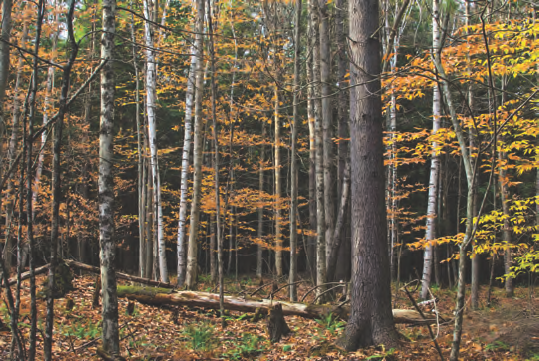Open Space: a Critical Asset in Norwich
Published Dec 1st, 2017 by Chris Rimmer
What do your favorite trail, your neighbor’s community-supported agriculture share, flood control, the odds of seeing a moose in town, and the iconic view of Norwich from Gile Mountain’s fire tower all have in common?
They all depend on intact open spaces. Luckily for us, our town provides many opportunities for enjoyable scenic walks, drives, and bike rides along contiguous forests, wetlands, old fields, hay meadows, and other open components of an historically rural landscape. These undeveloped expanses provide a peacefulness, sense of comfort, nostalgic feel, and for many a psychological benefit that developed lands in more residential and commercial areas do not. Such a strong, deeply-valued sense of place is a prime reason why maintenance and protection of open space is an integral part of strategic community planning.
Maintenance of open space promotes what are called ecosystem services: the benefits that humans freely gain from the natural environment. Norwich’s diverse mosaic of forests, fields, meadows, and wetlands supports viable populations of important pollinators, which are critical to our food production. Natural vegetation and intact wetlands act as a sponge and a filter, dampening flooding, reducing erosion, and cleaning surface waters of pollutants. Forest canopies filter out atmospheric pollutants and keep us cool on summer days by providing shade and retaining moisture between the ground and canopy. From providing scenic views to securing land for local farms to limiting future flood damage, there are many short-term and long-term reasons to protect open space.
Conservation of open space also provides food security in a world where the value of growing local food and using local resources wisely is ever more important. Across the open spaces of Norwich are found rich agricultural soils that should be both employed now and banked for possible future use, like a savings bond. Working forests are another important form of local agriculture, and their values increase with their size. Larger forests support a broader diversity of forest types, yielding a more diversified logging portfolio for landowners while providing improved shelter and food availability for wildlife. Even our iconic fall foliage is made more striking in diverse forests, where leaves of each tree species boast a different shade. Larger forests also support more viable populations of their component tree species, limiting the effects of inbreeding and increasing their resilience to insects, disease, and climate change. These productive forests are able to support a higher frequency of sustainable harvests, selective and small clear cuts, because substantial numbers of every age-class of trees continue to exist somewhere in the forest. Productive forests can provide long-term income and tax-relief benefits for landowners through programs such as Current Use. There are important food-security and economic reasons to protect open space.
 Forested open space on Blood Hill.
Forested open space on Blood Hill.
It is not just we humans who benefit from open space. Norwich’s many non-human residents &endash; flora and fauna alike &endash; flourish in our relatively undeveloped landscape. Large, core forest tracts connected by corridors support viable populations of the charismatic wildlife we associate with our rural landscape, some examples being moose, bobcat, black bear, fisher, and gray fox. These contiguous forests are also crucial homes to many breeding bird, bat and amphibian populations. The rich mosaic of different forest ages and types, logged areas, old fields, managed meadows, wetlands, and waterways that comprise Norwich’s open spaces provide crucial seasonal feeding, breeding, migratory, and over-wintering habitats for many species. The list of Norwich’s wildlife is impressive, including hundreds of mammal, bird, reptile, amphibian, fish, and insect species. This diversity alone provides countless ecological reasons to protect open space.
We can all do our part to ensure that open space remains a key element of Norwich’s future by making wise land use decisions and supporting strategic planning that clusters development into the historic villages, also referred to as the “hamlets,” of our town.
Originally published in Holiday 2017 Norwich Times